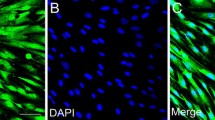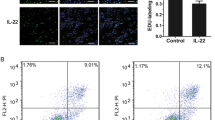Abstract
The proliferation and differentiation of Schwann cells are critical for the remyelination of injured peripheral nerve. Ginsenoside compound K (CK) is a metabolite produced from ginsenoside Rb1 which has strong anti-inflammatory effects. However, the potential effects of CK on Schwann cells have not been studied systematically before. Therefore, this study was aimed to explore the functions of CK in Schwann cell proliferation, migration and differentiation and its potential regulatory mechanism. Primary Schwann cells and RSC96 cells were treated with or without CK at different doses. The proliferation and migration of primary Schwann cells and RSC96 cells were examined by Cell Counting Kit-8 (CCK-8) and Transwell assays, respectively. The mRNA expression of myelin-associated glycoprotein (MAG) and myelin basic protein (MBP) was tested by quantitative real-time polymerase chain reaction (qRT-PCR). The levels of all proteins were examined by Western blot. CK could promote cell proliferation, migration and induce MAG and MBP expression in primary Schwann cells and RSC96 cells. Furthermore, CK activated MEK/ERK1/2 and PI3K/AKT pathways, and the beneficial effects of CK on primary Schwann cells and RSC96 cells were distinctly suppressed by inhibitor PD98059 or LY294002. Ginsenoside compound K induced cell proliferation, migration and differentiation via the activation of MEK/ERK1/2 and PI3K/AKT pathways in cultured primary Schwann cells and RSC96 cells.






Similar content being viewed by others
Data Availability
The analyzed data sets generated during the present study are available from the corresponding author on reasonable request.
References
Hung HA et al (2015) Dynamic regulation of Schwann cell enhancers after peripheral nerve injury. J Biol Chem 290(11):6937–6950
Liu CY et al (2020) Effect of exosomes from adipose-derived stem cells on the apoptosis of Schwann cells in peripheral nerve injury. CNS Neurosci Ther 26(2):189–196
Chew SY et al (2008) The effect of the alignment of electrospun fibrous scaffolds on Schwann cell maturation. Biomaterials 29(6):653–661
Ishikawa N et al (2009) Peripheral nerve regeneration by transplantation of BMSC-derived Schwann cells as chitosan gel sponge scaffolds. J Biomed Mater Res A 89(4):1118–1124
Triolo D et al (2006) Loss of glial fibrillary acidic protein (GFAP) impairs Schwann cell proliferation and delays nerve regeneration after damage. J Cell Sci 119(Pt 19):3981–3993
Zhu X et al (2016) Schwann cell proliferation and differentiation that is induced by ferulic acid through MEK1/ERK1/2 signalling promotes peripheral nerve remyelination following crush injury in rats. Exp Ther Med 12(3):1915–1921
Heinen A et al (2015) Fingolimod induces the transition to a nerve regeneration promoting Schwann cell phenotype. Exp Neurol 271:25–35
Yang Z et al (2012) Inhibition of P-glycoprotein leads to improved oral bioavailability of compound K, an anticancer metabolite of red ginseng extract produced by gut microflora. Drug Metab Dispos 40(8):1538–1544
Park ES et al (2013) Compound K, an intestinal metabolite of ginsenosides, inhibits PDGF-BB-induced VSMC proliferation and migration through G1 arrest and attenuates neointimal hyperplasia after arterial injury. Atherosclerosis 228(1):53–60
Park JS et al (2012) Anti-inflammatory mechanism of compound K in activated microglia and its neuroprotective effect on experimental stroke in mice. J Pharmacol Exp Ther 341(1):59–67
Lee HU et al (2005) Hepatoprotective effect of ginsenoside Rb1 and compound K on tert-butyl hydroperoxide-induced liver injury. Liver Int 25(5):1069–1073
Zong W et al (2019) Ginsenoside compound K attenuates cognitive deficits in vascular dementia rats by reducing the Abeta deposition. J Pharmacol Sci 139(3):223–230
Yang XD et al (2015) A review of biotransformation and pharmacology of ginsenoside compound K. Fitoterapia 100:208–220
Ma J et al (2010) Ginsenoside Rg1 promotes peripheral nerve regeneration in rat model of nerve crush injury. Neurosci Lett 478(2):66–71
Ma J et al (2013) The beneficial effect of ginsenoside Rg1 on Schwann cells subjected to hydrogen peroxide induced oxidative injury. Int J Biol Sci 9(6):624–636
Wang L et al (2015) Ginsenoside Re Promotes Nerve Regeneration by Facilitating the Proliferation, Differentiation and Migration of Schwann Cells via the ERK- and JNK-Dependent Pathway in Rat Model of Sciatic Nerve Crush Injury. Cell Mol Neurobiol 35(6):827–840
Hong BN et al (2011) Post-exposure treatment with ginsenoside compound K ameliorates auditory functional injury associated with noise-induced hearing loss in mice. Neurosci Lett 487(2):217–222
Oh J, Kim JS (2016) Compound K derived from ginseng: neuroprotection and cognitive improvement. Food Funct 7(11):4506–4515
Seo JY et al (2016) Neuroprotective and Cognition-Enhancing Effects of Compound K Isolated from Red Ginseng. J Agric Food Chem 64(14):2855–2864
Gupta R et al (2005) Shear stress alters the expression of myelin-associated glycoprotein (MAG) and myelin basic protein (MBP) in Schwann cells. J Orthop Res 23(5):1232–1239
Wang L et al (2015) Role of Schwann cells in the regeneration of penile and peripheral nerves. Asian J Androl 17(5):776–782
Frostick SP, Yin Q, Kemp GJ (1998) Schwann cells, neurotrophic factors, and peripheral nerve regeneration. Microsurgery 18(7):397–405
Kim JS et al (2013) Development and validation of an LC-MS/MS method for determination of compound K in human plasma and clinical application. J Ginseng Res 37(1):135–141
Quan LH et al (2011) Bioconversion of ginsenoside rb1 into compound k by Leuconostoc citreum LH1 isolated from kimchi. Braz J Microbiol 42(3):1227–1237
Cho SH et al (2009) Compound K, a metabolite of ginseng saponin, induces apoptosis via caspase-8-dependent pathway in HL-60 human leukemia cells. BMC Cancer 9:449
Zheng M et al (2018) Ginsenosides: A Potential Neuroprotective Agent. Biomed Res Int 2018:8174345
Lu MC et al (2009) Proliferation- and migration-enhancing effects of ginseng and ginsenoside Rg1 through IGF-I- and FGF-2-signaling pathways on RSC96 Schwann cells. Cell Biochem Funct 27(4):186–192
Wang B et al (2014) Protection of ginsenoside Rg1 on central nerve cell damage and the influence on neuron apoptosis. Pak J Pharm Sci 27(6 Suppl):2035–2040
Liang W et al (2010) Ginsenosides Rb1 and Rg1 promote proliferation and expression of neurotrophic factors in primary Schwann cell cultures. Brain Res 1357:19–25
Schnaar RL, Lopez PH (2009) Myelin-associated glycoprotein and its axonal receptors. J Neurosci Res 87(15):3267–3276
Ishii A, Furusho M, Bansal R (2013) Sustained activation of ERK1/2 MAPK in oligodendrocytes and schwann cells enhances myelin growth and stimulates oligodendrocyte progenitor expansion. J Neurosci 33(1):175–186
Newbern JM et al (2011) Specific functions for ERK/MAPK signaling during PNS development. Neuron 69(1):91–105
Funding
No funding was received.
Author information
Authors and Affiliations
Corresponding author
Ethics declarations
Conflict of interest
The authors declare that they have no competing interests.
Ethical Approval
The present study was approved by the ethical review committee of Yantai hospital of traditional Chinese Medicine. Written informed consent was obtained from all enrolled patients.
Informed Consent
Patients agree to participate in this work
Additional information
Publisher's Note
Springer Nature remains neutral with regard to jurisdictional claims in published maps and institutional affiliations.
Rights and permissions
About this article
Cite this article
Wang, H., Qu, F., Xin, T. et al. Ginsenoside Compound K Promotes Proliferation, Migration and Differentiation of Schwann Cells via the Activation of MEK/ERK1/2 and PI3K/AKT Pathways. Neurochem Res 46, 1400–1409 (2021). https://doi.org/10.1007/s11064-021-03279-0
Received:
Revised:
Accepted:
Published:
Issue Date:
DOI: https://doi.org/10.1007/s11064-021-03279-0




